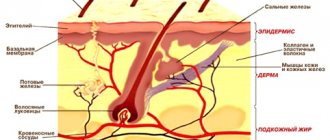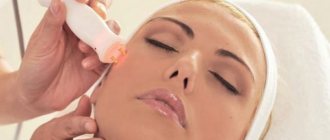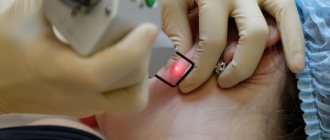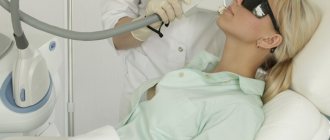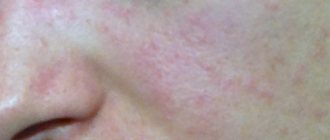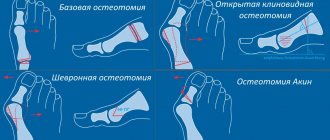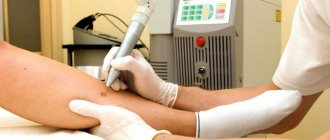Today I will tell you about the most popular alexandrite lasers today, which are used to remove unwanted hair, pigmentation and much more. These hair removal machines are also called the “gold standard” as their use is considered the most effective and fastest way to remove unwanted hair.
Not long ago I wrote about diode lasers. You can also get acquainted with the rating of diodes and the general rating of all laser hair removal devices, which are more or less popular in Russia
This rating of alexandrite lasers for hair removal was compiled by me taking into account the various parameters of each device, including price, quality, set of functions and technical features. Everyone can choose the device that suits them according to certain properties. After all, for some people the price comes first, while for others the technical characteristics of the device are important.
All the described devices have a number of common features and functions, while at the same time they differ in some properties, for example, the ability to regulate the temperature of the tip or the ease of transporting the device. It should be noted that the basic principle of all alexandrite lasers is painless hair removal by targeting the follicles and absorbing melanin. Read more about each device in my rating.
Comparative table of parameters of alexandrite lasers
| Name | CYNOSURE Picosure | Duetto Quanta System | CYNOSURE ELITE | Motus AX Moveo | Candela GentleLase Pro-U | IRRADIA TRIPLE |
| Device type | Picosecond laser | Laser system including alexandrite laser | Multifunctional device including an alexandrite laser | Alexandrite laser | Long-pulse alexandrite laser | Alexandrite laser |
| Wavelength(nm) | 755 | 755 | 755 | 755 | 755 | 755 |
| Frequency Hz) | 1-10 | 1-10 | Until 3 | 1-10 | To 10 | Up to 5 |
| Pulse duration (ms) | 2-10 | 2-100 | 2-50 | 2-300 | 0,25-100 | 2-50 |
| Light spot size (mm) | 15-50 | 8-14 | 3-15 | 5-20 | 6-18 and 20-24 | 7-12 |
| Radiation density (J/cm²) | 1-50 | Up to 25 | 25-100 | Up to 160 | Up to 560 | Up to 50 |
| Cooling system | Water+air+semiconductor cooling | Built-in cooling | Cold air | Built-in cooling | Using cryogen/air cooling system | Closed air-water system |
| Maximum tip cooling temperature (°C) | 5 | 15 | 15-30 | 15 | — | 4-15 |
| Electrical network requirements | 220 V, 50/60 Hz 20 A | 230 V, single phase 50/60 Hz 20 A | 200-220 V, 30 A | 230 V, 50/60 Hz 20 A | 230 V, single-phase 50/60 Hz 20 A | 220 V, 50 Hz, 15 A |
| Dimensions (cm) | 117x62x138 | 90x48x93 | 104x38x64 | 95x51x83 | 108x50x99 | 93x69x37 |
| Weight, kg) | 70 | 85 | 82 | 90 | 108 | 60 |
| Device price | 8.3 million rubles | 6.3 million rubles | 4.6 million rubles | 5.9 million rubles | 2.6 million rubles | 950 thousand rubles |
Ruby laser
A first generation technique that is practically not used today. This is a type of outdated laser for laser hair removal, the use of which carries the risk of burns and scars. Wavelength – 694 nm. This value is not enough to reach the follicle and quickly destroy the hair follicle.
Low power (40-60 J/sq.) does not guarantee that the hair follicle will be deprived of nutrition. One generated pulse lasts only 3 ms, which means that the duration of the procedure has to be increased.
Peculiarities:
- Effective only for dark hair and light skin.
- There is no way to remove light and red-colored vegetation.
- When used on dark, dark, tanned skin, there is a high risk of swelling and severe pigmentation.
- Suitable for use on the entire body.
The downside is that the procedure takes a long time, and this also applies to the course of manipulations. Due to severe discomfort, painkillers are used.
IRRADIA TRIPLE
Laser hair removal using the Swedish-made IRRADIA TRIPLE device is highly effective and acts directly on hair follicles that are subject to destruction. In this case, the device affects not only the follicles that are in the active growth phase, but also the dormant bulbs, which prevents the reappearance of hairs on the treated skin. IRRADIA TRIPLE has a number of advantages compared to modern devices:
- The duration of the hair removal procedure is minimal, which is achieved due to the size of the light spot and the high frequency of laser flashes.
- Laser hair removal procedures using the IRRADIA TRIPLE device are characterized by increased safety, since its operation has been tested by clinical trials and approved by the Ministry of Health of the Russian Federation.
- Epilation with this device is characterized by the absence of painful sensations, and thermal damage to the skin by the tip is prevented by a unique cooling system.
- The IRRADIA TRIPLE laser device can be used on any part of the body, including sensitive areas. In addition, hair removal with this device is equally suitable for both women and men.
Diode laser
The principle of operation is to act on melanin in the hair root and destroy it. When heated to 80 degrees, the cells responsible for hair growth die. The wavelength of the diode laser is 880 nm - this is enough to remove both light and dark hair. Therefore, it is suitable for all patients, regardless of color type. Using a diode laser device, only those hairs that are in the active growth phase are removed. This happens in 25 to 35% of people. The next batch of regrown hairs is removed during the second session. It will take about 4-6 visits to completely remove unwanted hair. Manipulations on the diode laser device are performed with a handle with a closed reflective surface. This allows you not to scatter the light beam, but to act precisely on the hair follicle. A vacuum effect is also created in the handle. This has a positive effect on the effectiveness of the procedure at relatively low power. Procedures using equipment with diode technology are safe and non-traumatic, because the beam is directed exclusively at the hair follicle and does not affect surrounding tissue.
Conclusion: The diode laser allows you to remove a large amount of dark and light hair quite safely and painlessly in a minimum number of sessions.
When is laser hair removal performed?
Hardware hair removal is not only a cosmetic procedure. Laser hair removal can be prescribed according to doctor's indications, for example, for hypertrichosis or hirsutism - diseases in which abnormal hair growth occurs. It also helps to cope with ingrown hairs and irritation from other methods of hair removal. This procedure is actively used by athletes who need aesthetics for the body (bodybuilding).
Candela GentleLase Pro-U
According to many specialists who have used this device in their work, Candela GentleLase Pro-U is the most powerful and effective of modern alexandrite lasers. A distinctive feature of this device is its convenient intuitive interface and the ability to adjust the pulse duration. Among the characteristics of Candela GentleLase Pro-U are the following:
- Effective hair removal of any type, even the lightest ones.
- You can use decorative cosmetics immediately after the procedure.
- The procedure is absolutely painless.
- There is no need for a rehabilitation period after the session.
- The effect of the hair removal procedure is noticeable immediately after the first procedure.
IMPORTANT! GentleLase Pro-U allows you to select the size of the anatomical spot required for laser treatment and adjust the radiation flux density. In addition, the device menu allows you to select a cooling system that is more suitable for a given skin type.
Motus AX Moveo
The Motus AX Moveo laser hair removal device from the Italian company DEKA has been proving its effectiveness for many years. Alexandrite laser using the unique Moveo technology allows you to effectively remove hairs of different shades and thicknesses on any skin phototype.
ATTENTION! Unlike other lasers, this device can be used even on skin after sunbathing.
The Motus AX alexandrite laser has a number of features that make it special among devices of this level:
- Hair removal with Motus AX is carried out as quickly as possible; it is capable of treating an area of 100x100 mm in 10-20 seconds.
- The contact cooling system of the tip allows you to treat any, even the most sensitive and hard-to-reach areas of the skin, without overheating it.
- The technology of the device allows procedures to be performed safely and painlessly.
- An hair removal session with the Motus AX device will provide the client with only pleasant tactile sensations.
Already the first procedure with the Motus AX device will allow you to process and eliminate up to 50% of unwanted hair, although after a few days the client may notice hair growth. However, this process is observed because the hairs begin to emerge from the hair openings. After 1-17 days they will begin to fall out spontaneously.
ATTENTION! This procedure can be repeated after 1-1.5 months, and the full course is 5-6 hair removal sessions.
CYNOSURE ELITE
Alexandrite laser CYNOSURE ELITE is a multifunctional system that allows you to effectively remove unwanted hair on any skin phototype. The gentle effect of the device on the skin makes it possible to use it even on the face and bikini area. One of the main advantages of this device is the wavelength of the laser radiation, which can vary from 755 to 1064 nm. This technology allows you to remove up to 98% of hair in the active growth phase. A wide range of light spots makes it possible to remove hair from hard-to-reach areas of the body with pinpoint precision. This procedure is available at any age and at any time of the year.
REFERENCE! In addition, the CYNOSURE ELITE device ensures the safety and speed of laser hair removal sessions. This device is also used for coagulation of blood vessels on the face or legs, treatment of age spots, and is even effective in the fight against acne and age-related skin changes.
Thanks to these properties, one visit to a cosmetologist will allow the client to solve several skin problems at once.
The difference between an alexandrite laser and a diode laser
An Alexandrite laser, compared to a diode laser, does not penetrate as deeply into the layers of the epidermis, and accordingly its effect is not as strong. Dense, dark hairs will take longer to remove. But for fair skin and fine hairs, this effect is optimal, since damage to the epidermis is minimal.
Diode laser can affect all skin types, but has a high percentage of side effects when removing hair from fair skin. That is why its cost is slightly lower. But the alexandrite laser device affects only 3 phototypes, but there are fewer problems after it, and the procedure itself is painless.
It is also worth noting that the diode laser is not able to cope with gray hairs. And his course of procedures is longer - from 8 to 10, while Aleksandritovsky has only 5-8.
An important point is that the use of an anesthetic gel when performing a procedure with a diode laser is mandatory. Whereas the alexandrite laser allows you not to use gel (experts recommend applying it at least to sensitive areas).
The main differences are presented in the table.
| Index | Alexandrite | Diode |
| Wavelength | 755 nm | 800 nm |
| Impact on skin phototypes | 1 – 3 | 1 – 6 |
| Cooling | Yes | No |
| Average spot diameter | 18 mm | 9 mm |
| Side effects | Low probability | High probability |
| Price per procedure | From 1,500 to 15,000 rubles. (depending on zone) | From 1,500 to 10,000 rubles. (depending on zone) |
Duetto Quanta System
Next in my rating is the unique alexandite laser Duetto Quanta System. The Italian laser hair removal system Duetto Quanta System is a unique combination of alexandrite and neodymium laser beam, which allows you to effectively remove hair and forget about it forever.
If necessary, you can use one of the specified lasers or their combinations according to the Mixed Technoogy system. You can also change the device attachments that are included with the equipment. The device is equipped with a built-in contact skin cooling system (SKIN COOLER), which provides reliable protection against burns and overheating of the skin during hair removal.
The device has the following advantages:
- This device allows you to perform fewer hair removal procedures compared to other alexandrite lasers.
- Duetto Quanta System effectively removes even gray and vellus hairs.
- Unique laser technology allows procedures to be performed even on tanned skin.
- A convenient and intuitive interface allows you to customize the device to suit any skin type and any hair structure.
- The effectiveness of hair removal with this device allows you to carry out procedures much less frequently compared to other lasers.
Types of ablative lasers and their specifics
Ablative lasers have varying degrees of ablation effect and simultaneous coagulation effect. As mentioned above, erbium lasers (Er:YAG) and CO2 lasers are used for ablative effects in cosmetology.
CO2 lasers
The active medium of a CO2 laser is a gas mixture, where carbon dioxide molecules play the main role. The carbon dioxide laser generates radiation with a wavelength of 10,600 nm (far infrared range). The wavelength falls on one of the peaks in the energy absorption spectrum of water. A feature of CO2 lasers is the greatest heating depth, that is, it simultaneously produces the greatest non-ablative (coagulation) effect in comparison with other ablative lasers. The CO2 laser has a pronounced hemostatic (hemostatic) effect (which, for example, is very weakly expressed in an erbium laser with a wavelength of 2940 nm).
The most widespread use of carbon dioxide laser in cosmetology is associated with the removal of tumors: this type of laser can easily be called a leader in getting rid of moles, papillomas, condylomas, dermatofibromas, warts and other benign formations of the skin and mucous membranes. For this purpose, nozzles with a fixed focal length (working spot diameter) are used. For this purpose, a special knife attachment is used. This method is effective not only for eliminating the aesthetic defect itself, but also for preventing relapses due to the coagulation of pathogenic cells during the procedure.
The next popular procedure using a carbon dioxide laser is the so-called laser resurfacing: smoothing the skin texture by evaporating its layers in problem areas. Laser resurfacing is used to correct cicatricial changes in the skin (including post-acne), scars, and stretch marks. It should be borne in mind that the complete removal of scars and cicatrices is rather a myth, but in reality, even an ablative laser can only make a scar or scar less noticeable: the surface of the skin at the site of the scar will be more even, smooth, elastic, and less different in color from the surrounding skin. To enhance the effect, a course of procedures can be used that combines the use of an ablative CO2 laser with non-ablative lasers (with mandatory adherence to the interval between procedures prescribed by a specialist), or with injection techniques, to improve the condition and appearance of the skin at the site of a scar or scar.
CO2 lasers also make it possible to achieve a noticeable effect of skin rejuvenation - due to ablation with a fairly large zone of tissue coagulation (warming). Today, for rejuvenation procedures using a carbon dioxide laser, devices are mainly used that operate according to the type of fractional photothermolysis (photothermolysis is the process of tissue destruction during the transition of laser energy into heat at the moment of its absorption by a chromophore): the laser beam forms microcoagulation zones in the form of “columns” perpendicular to the surface skin, so-called micro-therapeutic zones. The wavelength of the CO2 laser (10.6 microns) allows it to remove microzones throughout the entire depth of the epidermis (up to 20 microns) during this procedure. The coagulation zone reaches 150 microns or more, which provokes a reduction in denatured collagen fibers, resulting in a decrease in the total area of the skin, that is, tightening or correction of “excess” skin.
Ablative photothermolysis can be either superficial or deep. Superficial ablative photothermolysis allows one procedure to destroy a significant area of the epidermis. Cosmetologists use this method to solve problems in these layers of the skin: to correct pigmentation, actinic keratosis, even out skin texture and color. Deep ablative photothermolysis allows you to solve the problem of uneven relief in a short period of time: during laser exposure, a significant percentage of the skin is removed, visible lifting occurs due to the reduction of denatured collagen fibers around microzones. This method is suitable for solving skin problems at the dermal level (smoothing wrinkles, eliminating the effects of acne). With its help, we can work not only in the papillary, but also in the reticular layer of the dermis. The main thing is that the diameter of the microzone of damage does not exceed 500 microns.
It should be noted that thanks to the advent of fractional technologies, it was possible to reduce the number and severity of side effects (persistent hyperemia, post-inflammatory hyper- or hypopigmentation) when using carbon dioxide lasers to almost zero.
CO2 lasers are actively used in modern medicine. They are actively used in surgery (one of the advantages of the method of tissue dissection using a carbon dioxide laser is that the laser is capable of simultaneously coagulating small vessels, reducing blood loss to a minimum), gynecology, ophthalmology, urology, otorhinolaryngology, dermatology, neurosurgery, burn surgery, dentistry, oncology.
Natalya Vitalievna Kuznetsova, dermatocosmetologist, trainer at Victory of Beauty: “Quite recently, a new direction in the use of CO2 laser has appeared and is quickly gaining popularity - vaginal rejuvenation. This procedure is used to treat vaginal enlargement, dryness, and decreased libido. Using a special cylindrical attachment, the vagina is treated, micro-zones of ablation are formed in the mucosa, which contributes to its renewal, reduction of area, and improvement of blood flow. Treatment of the labia and perineum is used for aesthetic correction of the skin in this area.”
Erbium lasers (Er:YAG)
The erbium laser (Erbium:Yttrium-Aluminum-Garnet) used for ablation has a wavelength of 2940 nm. This wavelength occurs at the maximum peak of energy absorption by water. In a short period of time, the water boils and evaporates, without having time to transfer heat to the surrounding tissues.
In an erbium laser, the coagulation effect is minimal. An erbium laser can vaporize tissue to a depth of 4–6 microns (which is comparable to the size of cells in some layers of the epidermis and makes it possible to remove cells almost layer by layer). This precision has its advantages over chemical peels, where it is impossible to control the depth of exposure. That’s why “weekend laser peelings” are gaining popularity all over the world: having undergone the procedure on Thursday, the client can return to their normal rhythm of life on Monday.
Like the CO2 laser, the erbium laser is used for laser resurfacing procedures for general skin rejuvenation, wrinkle correction, relief improvement and lifting. The effects of carbon dioxide and erbium lasers are different. Thus, experts note that tissue healing occurs faster after resurfacing with an erbium laser, but a more pronounced rejuvenation effect is still achieved with the help of a carbon dioxide laser: thermally denatured collagen actively stimulates the work of fibroblasts, growth factors and other biologically active molecules are activated in the area of thermal damage, and the main result will be a pronounced lifting effect, reduction in the area of treated skin and correction of deep wrinkles.
Laser resurfacing using an erbium laser will be an effective and expedient way to improve microrelief, correct fine and moderate wrinkles, and pigmentation.
An erbium laser (like a carbon dioxide laser) can be used to remove some types of tattoos, for example, to remove multi-colored professional tattoos with shallow pigment. Removal is carried out using the vaporization method: along with the pigment, the top layer of skin in which the dye is located is also removed. If the pigment lies deeper, removal by ablative method is not practiced, since deep vaporization may leave a scar. (Remember that for tattoo removal today there is a wide range of non-ablative lasers that act on pigments of a certain color and depth, and it is also practiced (at the last stage of tattoo removal) to alternate ablative resurfacing and non-ablative laser exposure).
Er, Cr:YSGG laser
Er, Cr:YSGG laser (Erbium, Chromium:Yttrium-Scandium-Gallium-Garnet - erbium, chromium: yttrium-scandium-gallium-garnet) is a relatively new laser in medicine. Its wavelength is 2790 nm, which is less than the peak energy absorption of water (less than in an erbium laser, but more than a carbon dioxide laser). Used for surface and deep grinding. The advantage over the erbium laser is the effect of tissue coagulation and the absence of bleeding, a more pronounced lifting effect. Compared to a CO2 laser, it causes less thermal damage to tissue.
The fundamental difference between the effects of Er:YAG, Er, Cr:YSGG and CO2 lasers on tissues:
- Er:YAG – pure ablation without heating the surrounding tissues;
- Er, Cr:YSGG – ablation + small zone of coagulation of surrounding tissues;
- CO2 laser – ablation + powerful heating of surrounding tissues.
Liliana Vladimirovna Myslovich, Associate Professor, Department of Dermatology, RUDN University, Medical Director of Alma Lasers:
“I would like to note that thanks to innovations in the field of laser technology, today it is possible to regulate the duration and power of CO2 laser radiation so as to perform both absolutely superficial grinding with a minimal coagulation zone, and very deep effects with a wide coagulation zone.”
A variation of the erbium laser is the dual-mode erbium laser, Er:YAG, with a wavelength of 2940 nm. This is a relatively new technology that combines ablative pulses (high power pulses) with coagulation pulses (low power), allowing complete and independent control of the severity of ablation and coagulation. This allows you to flexibly adjust the laser exposure parameters depending on the cosmetic defect. A dual-mode erbium laser allows you to combine pulses for ablation (evaporation) and coagulation (heating). If a coagulation effect (collagen heating) is required during the procedure, a dual-mode laser can generate a pattern of subablative pulses that will not evaporate the tissue, but will heat the cells to the required depth, which can also be adjusted depending on the tasks.
Among ablative lasers, we can also mention thulium ; it generates a constant wave with a length of 1927 nm, which specifically affects the epidermis at a limited depth. The gentle effect of the laser allows treatment of up to 70 percent of the surface of the skin in need of treatment or correction. Initially, the thulium laser was used for surgical operations in urology, general and thoracic surgery. With its help, you can perform operations with minimal damage to surrounding tissues, smoothly excise and evaporate tissues with the generated laser beam. In cosmetology, thulium laser is used to gently treat the skin and combat pigmentation.
CYNOSURE Picosure
The leader in my rating was a new product from the American company CYNOSURE - the picosecond laser Cynosure PicoSure, a unique invention of aesthetic medicine with a PDA certificate. This device is mainly intended for removing tattoos of any complexity and on any area of the skin, however, it is also used with equal effectiveness for epilation of unwanted hairs.
The safety of exposure to picosecond pulses allows the laser to be used in the area of the eyelids, eyebrows and lips. The device is equipped with a unique cooling system that combines the effects of water and air when treating the skin, which minimizes pain during procedures.
REFERENCE! Picosecond pulses, which are 100 times shorter than nanosecond pulses of previous generations of devices, act on the skin not thermally, but mechanically, without damaging it.
This allows the device to be used for skin rejuvenation procedures. In addition, such a system significantly reduces the duration of the procedure to several minutes.
Rating of alexandrite lasers
- Cynosure PicoSure
- Duetto Quanta System
- CYNOSURE ELITE
- Motus AX Moveo
- Candela GentleLase Pro-U
- IRRADIA TRIPLE
So I introduced you to my rating of alexandrite lasers, which are considered the most popular in modern cosmetology. Which one to choose is a personal matter for everyone; I just analyzed their work. But before you decide to buy an alexandrite laser for hair removal, weigh the pros and cons, study the contraindications and nuances of use. I hope my rating will help both cosmetologists in choosing a device for work, and their potential clients when visiting a salon.
